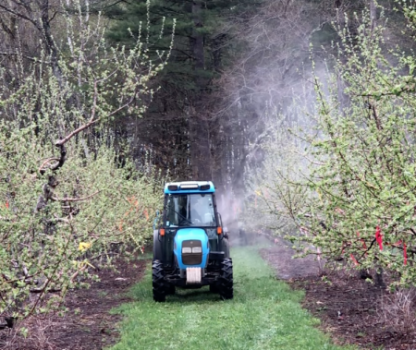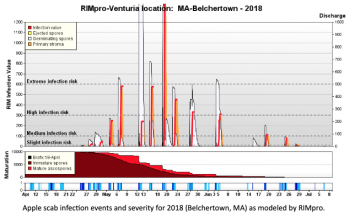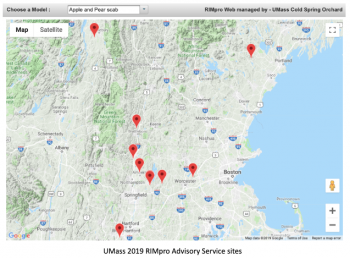Jon Clements and Elizabeth Garofalo, UMass Extension
Massachusetts (and beyond) apple growers have a choice of three Decision Support Systems (DSS’s) in 2019. NEWA, Ag-Radar, and RIMpro. These are websites that use site-specific environmental (weather) data to feed into apple pest and horticulture models that help make orchard management decisions based on this weather information. Most use degree-days (with various base temperatures), precipitation, relative humidity and leaf wetness, and (sometimes) user-entered tree phenology (bud stage) or insect trap captures to best inform and start the models. Note that both history and forecast model outputs are available, realizing that future model predictions are only as good as the weather forecast that goes into them. Hence, the following caveat applies - Decision Support Systems are intended as guides only. To quote the UMaine Ag-Radar introduction web page “The best decision tools are the experience and knowledge between your ears, supported by input from direct observations.” We couldn’t have said it better. A brief description of each DSS and how to get it for your site follows.
Network for Environment and Weather Applications (NEWA), is run out of Cornell University’s New York State IPM Program and the Northeast Regional Climate Center (NRCC). The website is http://newa.cornell.edu/. Access to the website is free for anyone, however, despite the perception NEWA is free, it is not. UMass Extension, thanks to USDA grant funding, pays $1,750 per year to have NEWA host our Rainwise weather station-based sites. (Not to mention a certain amount of staff time/maintenance/weather station depreciation, etc. dollars. Estimated to be about $500 per year per station. ) Currently, there are 43 NEWA sites in Massachusetts. 21 of these are on-farm weather stations (Rainwise or Onset) and 22 are airports (believe it or not). Anyone can look at the models from these sites by going to the NEWA website. Some of the more relevant orchard models include apple scab, fire blight, codling moth, plum curculio, apple maggot, and apple carbohydrate thinning. But be advised, the conditions may not be the same at your location if you are using an off-site station. Therefore, you are encouraged to purchase a weather station and get on NEWA if you really want to use it most confidently. In Massachusetts, contact NEWA state coordinator Jon Clements, jon.clements@umass.edu if you have questions or want to establish a NEWA site. Expect a major NEWA website update in the next year.
RIMpro is a cloud-based service that according to their website, https://rimpro.eu/:
“RIMpro...is an interactive Decision Support System (DSS) for pest and disease management in fruit and wine grape production. For many growers and consultants RIMpro is their essential tool for effective crop protection. Connect your weather station to the system in minutes. Get valuable real-time information to manage your crop protection in integrated, low-input or organic production systems. The RIMpro simulation models are carefully developed in cooperation with specialist, worldwide validated, and widely used. User-friendly interfaces show you what you need to know to make your decisions. RIMpro is no black-box. All biological processes in the models are explained and you can set all simulation parameters to your personal experience. RIMpro is constantly developed further based on user feedback, input of working groups and projects, and new insights in the biology of the pests and diseases involved.”
OK, sounds good, but not so fast. RIMpro is definitely not for everybody. For starters, it costs 220 Euros per year (about $250 USD right now) plus, at least in our case, supplying it with weather data costs about 50 USD per year. There are two options for getting weather data to RIMpro, using a NEWA site or using their virtual weather data source Meteoblue. RIMpro is arguably the “Cadillac” of DSS’s for apple growers, with extensive and detailed models for apple (and pear) scab, fire blight, codling moth, sooty blotch, fruit thinner, and some more esoteric ones like sawfly, mildew, and Marssonina. (Among others. It also has grape models.) Hence, not for everybody, you have to really be kind of into it.
But, for the past two seasons, the UMass Extension Fruit Team has hosted a RIMpro Advisory Service. That makes it much easier for you to get going with RIMpro, and we try to provide timely updates based on the most important RIMpro models. In 2018 there were eight orchards in Massachusetts, two in Vermont, one in Maine, and one in Connecticut who were participants of our UMass RIMpro Advisory Service. We plan on going at it again in 2019, the price will be $300. Contact Liz Garofalo or Jon Clements for more information or to sign-up.
Ag-Radar, created and curated by Glen Koehler at UMaine has been given a “weblift” and will be available through a for fee subscription (estimated launch date April 1, we will send out the notice when this becomes available to you). Ag-Radar will continue to offer the same services we have come to appreciate. These include (but are not limited to) the apple scab model, fireblight model, and one of my favorites, the honeybee activity model, designed to help you to avoid applying material at peak honey bee activity times. In addition to the suite of models already contained in Ag-Radar, there will be an expanded plum curculio model, a new sunburn model and more detailed frost warnings. To navigate to the site in your browser, use this link: http://agradar.info




